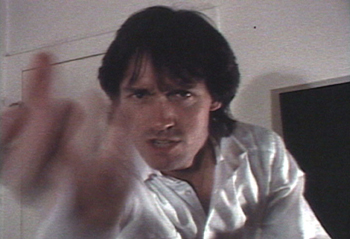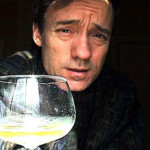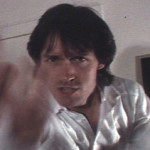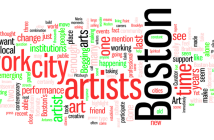Christian Holland: I think this is the 3rd time you've been in the Whitney Biennial?
Joe Gibbons: It's actually the 4th time, starting in 95, I think.
CH: I guess the first time an artist is in the biennial, it's a huge stepping stone, but perhaps with the 4th time, it isn't the same? Does it re-instill the same cachet that being in the Whitney biennial the 1st time does?
JG: It's pretty much the same, but not in those terms. In a sense its re-enforcing or re-affirming the insignificance of non-collectable art in the scheme of the art world because it's never really meant anything [to me]it's never really helped me...it's always a kind of shock to see how little respect the non-collectable or non-commodity forms of art are treated at the Whitney museum and elsewhere in the art world, but there are lots of video and film installations in the Biennal, but about half of them have gallery representation and are treated as collectable items so they have their own rooms and special exhibitions requirements taken into account. But without that they're [film and video works]just sort of shunted off into a corner, literally--the video artists without gallery representation are actually shown on a small flat-screen monitor in a corner next to the elevators in the lobby... So it's nice to be in the Biennial, it's good for our resume...
CH: (laughs) Yeah.
JG: But other than that it's never really done very much for me.
CH: Do you think this is similar to your experience or the way you see the art world, especially in NYC?
JG: Yes, but it's become more glaring since the mid-90's. It's more this dichotomy, or this separation between gallery film and video, and film and video that might have similar concerns but doesn't have gallery representation, it's instead shown in the festival circuit or outside of the gallery context. There's become more of a separation. Before, in recent years, film and video installation had more of an object based context. There were sculptural elements to them but now that gallery filmmakers and videomakers don't need any other support, except for a projector, they're almost indistinguishable [from other film/videomakers]except for the presentation, the seriousness with which they're taken by the art world, and prices that they command.
CH: Where are you distributed?
JG: Video Data Bank and Canyon Cinema--Canyon Cinema is the distributor of the films and videos--New York Film-Makers Coop in New York, but Video Data Bank actually promotes the work. But they don’t have the same cachet or power that an institution like Artangel has, which supported one of the video installations that occupies the film and video gallery where usually the video art is shown in rotation, but this one occupied it for several opening nights.
So Video Data Bank, Canyon— plus I haven’t given them my last couple of things because I didn’t think they were finished, if they thought I’d be showing them, but they haven’t helped in that way because I haven’t asked them for any help.
CH: Works that were included in the Whitney Biennial?
JG: Yes, both this Biennial and the one in 2002. Confessions of a Sociopath—yeah, I’ve never actually, sort of, released that for distribution. Still working on it.
CH: You’ve just finished part 2?
JG: Well, no, not really. I’ve been working on that and it’s kind of funny the way I get—what helps me to finish videos is by announcing that they’re finished and setting that date and having a place to show them. And the pressure, hopefully will force me to finish the work.
CH: (laughs) mm-hm.
JG: I would just take a long time and maybe be too perfectionist. But in this case, I think the Whitney thought I had shown it in New York in the fall, but I actually hadn’t. They wrote about it as though I had. But it’s not actually in this Biennial. So yeah, part 2 is still in the works.
CH: I see. Any upcoming screenings for it? That will, maybe, push it to completion.
JG: No, I need to set another date somewhere. But also I’m thinking about making Confessions of a Sociopath part 1, part 2 and part 3 all into one big piece, one feature length piece. Which is another way of getting a little more visibility and getting taken more seriously—is to have a feature length film. It is the other route—you can either go try and get into the gallery world and be treated seriously as a video or film artist and make fifteen minute pieces or ten minute—but if you’re showing in, say, a festival circuit or beyond, then short works are not as visible at film festivals as feature length works so a lot of people try to make feature length to get the visibility and respect or attention.
CH: Is that the way you typically go? Do you try for the festival circuit over the gallery world?
JG: Yes, yes, because it’s sort-of more the world that I know. Although for years I made films and videos without really being part of that. Partly because I used to make Super 8 films and film festivals wouldn’t show Super 8 and also because the art world seems very unreal, compared to the festival world—the festival world seems more like real people although it’s not really; it’s just—there’s less pretension and mystification in the festival world which is more a commercial world of real consumers. Whereas the art world seems really full of hype—I mean a different kind of hype—and pretentiousness and snobbery, and I’m just not—there’s just something that is suspect about the gallery world, although there’s a lot of good art that’s there. I think that they are almost synonymous with fashion shops—the way they look like and are almost designed like boutiques and they could almost be— they were side by side with boutiques in SOHO and then they moved into Chelsea and now there are boutiques there too, be it clothing boutiques, art galleries…
CH: And I think in this Biennial there’s some examples of intertwining of fashion and art and also popular music which also may be characteristic of what you’re talking about.
JG: Yeah, I guess there is—Music is also very—I mean it can be—fashion driven. It seems more authentic, at least the more grass-roots kind of music or music that comes out of people discovering music instead of people relying on advertising. More underground types, but the kind of fashion that’s more idiosyncratic; and just made by individuals without concerns for big sales, just as expression, but, yeah, that’s not the kind that I’m thinking about.
CH: I wanted to ask about something that was written about you in the catalogue. It says: ‘Since the 1970’s Joe Gibbons has fashioned a volatile, erratic and eminently untrustworthy and scathingly funny persona.’ Why do they say ‘eminently untrustworthy’? Or if you agree with that, to start with?
JG: Oh, I do. At one point I was making these autobiographical bit films in the 80’s but I got tired of that and suspicious of the implied sincerity of that form, because it was always a persona that I was using and it was always fiction to a degree even after everything it was something that really happened. Since I’m in the films, the way I reacted to them and talked about them was sort of a fiction. So what I’ve been doing more and more lately is fictionalizing the documentary aspect—either through the persona or actually fictionalizing the events that I’m filming. And I’ve always done similar things where I just lie. And maybe it’s a reaction to the sincere kind-of diary and autobiography film mode. It’s not just in film and video, it’s everywhere now: the Memoir—people telling the stories of their lives. But I couldn’t do that anyway, I just can’t be that sincere. So I really push things to extremes, but I try to maintain some sort of verisimilitude, so it might get taken for the truth.
CH: Where does Confessions of a Sociopath fall in to that change from the mid-90’s type of work to the work that you’re doing now?
JG: Well, I shot a lot of that in the 80’s—70’s, 80’s, and it was all pretty straight forward in framing it. Well, in the first part it’s really just contextualizing all this material with hospital notes and the doctor’s notes. I got the records from McClane’s Hospital; I spent time there. So those are all verbatim. But just by framing my home movie footage with that it’s distorting it. So it really may look much more pathetic than I really was, I think at that time. And more solitary, because you don’t see any other people, really. So that’s fiction; even though the materials are all unaltered, it’s just what’s left out that makes it fiction. I also threw in, I think, a few things that were not straight—actually there’s very little, but people still think I made up a lot of it. The thing with my psychiatrist, my real psychiatrist is a fake and they think that the whole thing’s made up and sometimes none of it. But I guess that they just don’t trust that it’s true. But sometimes it’s not true intentionally and sometimes people just don’t believe me. Like the job search that I do at one point in the movie and it’s all, I mean, it wasn’t serious at all. I was looking for a job then, but I just started having fun with it—calling jobs that I could never get. On the other hand, it doesn’t seem like I’m trying to fool anybody into thinking that I’m trying to get a job as a flight instructor. I don’t know what people think about that.
CH: (laughs) They probably think that it’s—let’s see, ‘scathingly funny’ as the Whitney puts it. That’s actually the first film of yours that I saw and I actually thought all the things that your describing. I couldn’t tell if it was a movie someone made about this fictional character, ‘Joe Gibbons.’ Or Joe Gibbons had made a documentary about himself and I could tell what was real and what was made up. It seemed that some parts of it were staged, liked the parts with the psychiatrist, but other parts seemed like a reality television show with a hidden camera.
JG: Yeah, that psychiatrist was from the early 80’s. And some of that footage was from a film I shot in Boston when I lived there in 1984. I just filmed a lot that year or 84-85. And I was seeing him regularly and he just let me bring the camera in, but I never expected that it would look staged; it was really surprising to me. Due to maybe putting more of him in? or I don’t know if I should even worry about it. It was after that film, Living in the World that I started going towards—I started out with a film I shot in Paris. It starts out where I’m just trying to avail my parking tickets and then I just take off for Paris. I tried to do a fictional film, but with people that I was involved with; although that wouldn’t be called an untrustworthy narrator—the untrustworthy narrator in that literary, sort of, mode which has a long history. But you were asking me about the footage where you couldn’t tell. I guess people that know the other films have a different take on them because they know—I guess they have a similarity with the other films and [the viewers]know where things deviate, but most people don’t.
CH: In your films do you look at yourself as an actor?
JG: I guess—I don’t know if I sent you the Room 1040?
CH: Yes.
JG: That one is not in the program—well, actually maybe it is. I could fit it in—I told them the works weren’t finished that I was showing. I get two weeks before the first screening, so that’s part of Doppelganger. That one—I am, sort of, acting. That’s sort of untrustworthy, but no one really thinks that I’m killing people. It’s how I might end up. It seems more poignant; at the end of Sociopath, the doctors saying I’ll be spiraling downward and it’s hard to know where I’ll end up. When I follow that with Room 1040, it seems like one possibility. There’s some films I made in the 90’s, like with Tony Oursler, where I'm really acting, there’s nothing remotely like reality in those. We play these institutionalized psychiatric patients. That’s sort of sub-acting, but it’s certainly not cinéma vérité. I never considered myself an actor, except, I had to make this feature film, in the early 90’s, and in that it was sort of performance, but was construed more as acting because it was a feature film with a plot, but I’m not an actor, I can’t do the things that actors do. Louise [in the background]is saying that in Doppelganger, I am acting—Yeah, I guess so, but I don’t, become another person. I do act in a way, but I call it performance anyways.
CH: In Confessions of a Sociopath, one of the issues that may lead people to say that it’s untrustworthy is that there’s different personas in it of you, aside from it taking place over a few decades there’s also what may lead people to think that the parts with the psychiatrist are staged is that you have a very sarcastic tone in your voice, whereas in other parts you’re very stoic or very calm, direct.
JG: Yeah, meaning when I’m talking with the shrink? The psychiatrist?
CH: I think so.
JG: I guess so, that certainly wasn’t an accurate portrayal of our sessions. Although, I guess I used to joke around a lot. He used to have me lie down on the couch because he thought I’d be less other-directed and less jokey if I were lying down and not looking at him, but that wasn’t acting at all. I was really performing there.
CH: Also in A Time to Die, it seems to be performance, it’s somewhere in between performance and acting. When I watched it last night, I was just thinking that this is Joe Gibbons performing or doing a reenactment of the person who actually does what happens in A Time to Die, because this isn’t Joe Gibbons’ real persona, but you’re not putting on a mask to carry out this person’s actions, you’re just performing or reenacting.
JG: I guess I don’t know who that is, I’m not really changing my voice or anything, but that kind of psychopath- I’ve done a lot with that sort of character. I’ve done a lot of these flower things. They’re in a couple of other things, but I’ve never made one like that. But, I’ve shot a lot of stuff like that. But I don’t know what to say about that. It’s not a reenactment, because I would never do that without having a camera on me. Usually, I’m more gentle with flowers and understanding of their vanity.
CH: I guess, I’ve only seen the 3 films of yours that you sent and Confessions of a Sociopath. They all deal with some sort of neurosis and you talked about a film you did in the 90’s about a Psychiatric patient. Do all of your films take on those kinds of issues? Or use that as their material?
JG: I think they do. Even the short films; I made a series of Pixel Vision tapes using the Fisher Price toy camera. I play either a psychiatrist—usually a fraud, or, someone who thinks he’s an expert or wants to be. Or someone without any pretensions—a psychopath. And then the Barbie doll has her own disorders, like in one [film]she has multiple personality disorder, and in the others she’s actually just a young person who wants to be an actor and I take advantage of her—I’m the producer. She’s too young to have problems in that one. In another one she has, kind of, trauma. I just think that’s where the most interesting issues are. I guess in most drama there’s some kind of flaw that drives the drama and I think by exaggerating things—I mean, I play pretty messed up characters, but there are aspects that everybody to a greater or lesser degree exhibits, especially the psychopathic ones; people can identify with that. So many movies are made involving these characters. I started out making more abstract films or structural films and it wasn’t until I discovered using myself as material that I thought I had something. But I had to keep making more—I needed content. By finding flaws and working on those—that was a goldmine. I just worried if I had enough problems within me that I could exploit. So when I ran of my own—I started creating them—I made one or two films based on drug addiction. Before that it was voyeurism; I sort of discovered and cultivated a voyeurism in myself, so it started out being a theoretical film but it turned into a film exploring my own perversions.
CH: What film was that?
JG: That’s Spying. And then I made another film about drug addiction, I thought I’d just cultivate a different problem in myself to make a film about it, but I couldn’t really continue that, and that was also not really true—the film was a rationalization for the drugs. I was involved with all this as research. The romantic idea of the artist getting involved in these kinds of activities as a kind of research, gaining experience. But that was a big inspiration on me; the symbolist French poet, Rimbaud’s dictum that the poet should consume all poisons and go into the unknown, the depths of degradation to bring back his findings, that I read when I was a teenager and it made a big imprint on me.
CH: It seems to have stayed. Probing the depths of our personalities just to make art...
JG: Yeah, although I am going more into fiction—well, more recently it’s gotten much darker. I play a character that’s more homicidal in the last things that I’ve shot. But maybe that’s just an expression of our times.
CH: (laughs) Why do you say that?
JG: Well, the United States is becoming more sociopathic, I think. But that last film festival I went to and this Whitney Biennial is being described as very dark.
CH: Yeah, they were saying in some review that there’s a lack of beautiful works.
JG: Yeah, that’s probably true. I haven’t seen enough of it to verify that—too crowded when I’ve been there and I haven’t read any reviews either; I missed the New York Times review. But that’s just what one of the curators told me—that people are saying it’s very dark, but that was also said about the Rotterdam film festival—a huge film festival with films from all over the world. That’s just how people are seeing things now, understandably.
CH: I guess the curators were saying—they titled it Day for Night—and it’s less a sampling this year than it is a thesis. Is that true from what you’ve seen?
JG: I think of the title as "The America Night" also, because that’s the literal translation of La Nuit Américaine, that Truffaut film. What the French call day-for-night technique. I think that’s not an accident, “The America Night,” but I talked to one of the curators, Chrissie Iles and she said that they had put it together so fast that they missed a lot of things. It is just a sampling; I think there could be a lot of other things in there and I guess it’s always a thesis. But I guess they wanted it to be more of a thesis this year, I think, because in the past it’s been several curators and they’ve each been finding works and they put them together and they find that they are jarring and that they don’t often work together and in this case they were consistent, they elaborated on every choice—the two Curators. So I think it is much more of a coherent vision, thesis of their own, with a really strong political point of view; political and philosophical so I think they intended it to be dark.
CH: There are a lot of hotel rooms in your recent work. Why is that?
JG: Partly because I don’t have a place to—because they’re sets. They’re sets that aren’t contaminated with emotional associations. And I don’t have a studio, I don’t make sets in Boston; it’s hard to film there. So when I travel, it’s an opportunity for pre-made settings. I’m eager to make up things when I’m in an environment that doesn’t have any familiar element. And so it’s appropriate for this Doppelganger theme. Maybe Doppelganger isn’t the best title; I’m thinking of changing it. It’s more like the “Underground Man.” I guess someone whose sort ruthless and alienated and moving through the urban bases—everywhere. And the hotel rooms really—and also I have time, I don’t have a lot of obligations really, so I have more freedom. So whenever I travel I bring as much equipment as I can. Last summer I went with Louise to Buffalo; we spent a couple of weeks up there at the Lenox hotel and shot a lot of things. That was a great space. The Producer was one of the things I shot there.
CH: I saw that The Producer is one of the pieces being screened in the Biennial. It’s a piece that you did with Tony Conrad along with Louise?
JG: Yeah, that was one of the things that we shot where each sort of took turns setting up things. That was one that Tony Conrad set up and Louise and I sort of played along with him and I filmed it. It could be there under his name, but he didn’t want it under his, but it was shot in the Lenox Hotel.
CH: Does Tony Conrad often use himself in his works?
JG: Yeah he does and I think that’s where I got the idea to use myself. He used to make very structural films and he used himself in a series of Super 8 films where he was berating the Super 8 films for being lackeys of Kodak and the cinema industry and being manufactured to meet specifications and just being little pawns, machines. And he did a bunch of scenes where he destroyed a bunch of them in different ways; he tortured them. And I liked that way of talking to the camera—very personal—so I adopted that. He still uses himself in his films but not that much.
CH: And again I’ve only seen four of your works, but Confessions of a Sociopath and A Time to Die are both very funny films and I was curious to see how much humor plays a role in your process.
JG: A lot because—and maybe it hasn’t helped me—I mean, it’s helped me in a way, but I can’t take myself that seriously. I feel self-indulgent and just boring without some comic relief, but I guess it’s also how I deal with my life. But there’s also the problem that humor is not taken seriously. In Hollywood, comedy never wins the Academy Award. The Academy prefers uplifting movies and movies they feel are very serious and comedies just aren’t perceived that way. Well often they’re not; they are sort of like confections. But in the art world, too, it’s even less quick to deal with humor; it’s very rare. The art world takes themselves much more seriously than the Academy of Motion Picture Arts and Sciences. Comedy makes people unsure of whether it’s elevated enough to be art, although there is William Wegman and Mike Smith, although Wegman got out of that stuff to do paintings. With his dog photographs he made a lot of money, but it wasn’t considered art, but he does do paintings. Yeah, George Kuchar, his videotapes are really funny and they get shown a lot, but he’s not taken seriously in the art world.
CH: Were you surprised that A Time to Die was included in this show?
JG: No, not really, because, well, it’s dark; that helps. The works they’ve shown before were funny. In 1998 it was one with a Barbie doll where I’m playing a psychiatrist and trying to draw out her multiple personalities and that ends darkly too—I get hammered unconscious by a Barbie doll; she attacks me. A Time to Die is playing on a monitor—I mentioned that monitor that was off in the corner—so I don’t know what people’s reaction is to that. I don’t know if there are other things like it, but it is a little odd to have it there [at the Biennial]. They also liked another piece that I had submitted—it was just really comical. I play a genius consultant to a little girl starting at an age right after she’s born, but that was a collaboration with someone else and they hadn’t contacted the other person and it was after they published the list of artists. They wanted to show it, but the collaborator hadn’t been asked. They are open to comedy, but I didn’t seem very much of it there, and there usually isn’t.
CH: I have one last question for you. How often do you work with Louise, or have her consult with you?
JG: We don’t collaborate, but we do work on each other’s pieces a lot in the editing phase or in the shooting, concepts. Mostly in the editing is where we collaborate a lot. We have very different sensibilities. We agree usually on the editing, so we’ve been crediting each other on the editing.
CH: Okay, thank you very much for the interview.
Links:
Whitney Biennial
"Whitney Biennial 2006: Day For Night", is on view from March 2, 2006 - May 28, 2006 at the Whitney Musuem of American Art.
Joe Gibbons' films were screened on Sunday, March 19th and will be screened again Saturday, April 8th at 2:00pm.
All images are courtesy of the artist.
In our previous article on Joe Gibbons and Louise Bourque we regret the following errors:
-Gibbon's film Barbie’s Audition was not vetoed by the Sundance film festival, but the Sundance Channel.
-Gibbons work with the Fisher Price children's camcorder was not part of his early work, but occurred much later.
We regret the errors and always strive to convey correct information to you.





